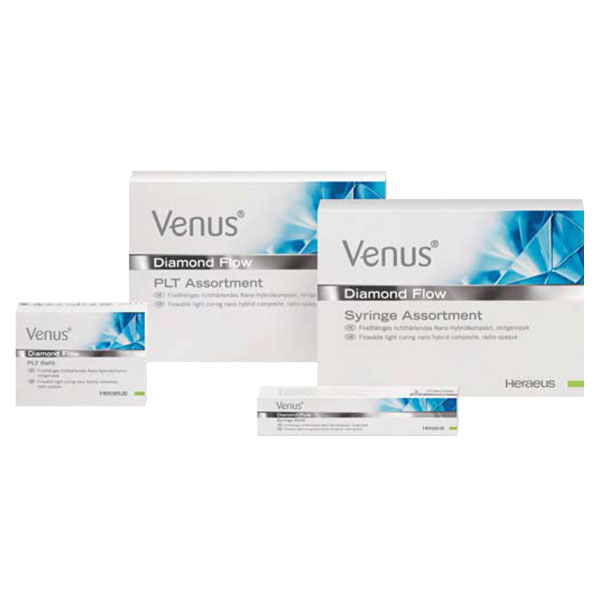Venus Diamond Flow
Venus Diamond Flow is the new flowable composite based on nano-technology. It fits perfectly to the chemistry and colour shade system of Venus Diamond and creates high aesthetic results. This material can adapt uniquely to the colour of the surrounding tooth structure and features an outstandingly natural look. The new design of the Venus Diamond Flow syringe ensures that the material can be applied easily and reliably. Highly aesthetic results are attained in only a few steps. The flowable composite retains its shape and position following application. It flows only when pressure is applied with an instrument due to its thixotropic characteristics.
Indications
- Enlarged fissure sealing
- Cavity lining - as the first layer for class I and II
- Class V fillings
- Minimally invasive class I and II fillings in areas not subjected to masticatory forces
- Minimally invasive class III fillings
- Small repairs of direct and indirect restorations combined with a suitable bonding agent
- Splinting of mobile teeth
Benefits
- Convenient Flow-behavior (Thixotropic)
- Very high radiopacity
- Low shrinkage stress and high flexural strength
- Very good polishability
- Fits perfectly to Venus Diamond
Venus Diamond Flow
Sponsored Links...
Upcoming Events... |
|---|
|
Jan 01 2025
TRIOS Care EXCLUSIVE: 1:1 Virtual Session (Book from 1st Jan, 2025)Australia & New Zealand, AUSTRALIA |
|
Mar 04 2025
Dental Review 2025 - 22nd International Dental ForumMoscow, RUSSIA |
|
Mar 12 2025
|
|
Mar 15 2025
Mastering Your Practice Exit StrategySydney, AUSTRALIA |
|
Mar 17 2025
Webinar - Digital Denture Study Club: Session 1Australia & New Zealand, AUSTRALIA |
|
Mar 18 2025
TRIOS Café Webinar - A-Z Cosmetic Workflow with TRIOSAustralia & New Zealand, AUSTRALIA |
|
Mar 19 2025
ITI Congress ColombiaBogota, COLOMBIA |
|
Mar 21 2025
SIDO International Spring MeetingFlorence, ITALY |
|
Mar 21 2025
ITI Congress UK & IrelandBirmingham, UNITED KINGDOM |
|
Mar 22 2025
|
|
Mar 24 2025
31st Global Dentists and Pediatric Dentistry Annual MeetingDubai, UNITED ARAB EMIRATES |
|
Mar 25 2025
IDS 2025Cologne, GERMANY |
|
Mar 29 2025
Mastering Your Practice Exit StrategyMelbourne, AUSTRALIA |
|
Apr 02 2025
Functional Dentistry Congress 2025Kyoto, JAPAN |
|
Apr 10 2025
New Orleans Dental Conference and LDA Annual Session 2025New Orleans, USA |
|
Apr 12 2025
ITI Congress Southern AfricaCape Town, REPUBLIC OF SOUTH AFRICA |
|
Apr 15 2025
Belarus Medica 2025 - 30th International Medical ForumMinsk, BELARUS |
|
Apr 15 2025
|
|
Apr 17 2025
Dental Forum 2025London, UNITED KINGDOM |
|
May 01 2025
IAO Annual Meeting 2025 - International Association for OrthodonticsWashington D.C., USA |
|
May 08 2025
PNDC 2025Seattle, USA |
|
May 08 2025
39th Australian Dental CongressPerth, AUSTRALIA |
|
May 08 2025
TDA Meeting 2025San Antonio, USA |
|
May 12 2025
APDC 2025 - 46th Asia Pacific Dental CongressManila, PHILIPPINES |
|
May 14 2025
CSDA's 158th Charter Oak Dental MeetingUncasville, USA |
|
May 15 2025
NCDS 2025Myrtle Beach, USA |
|
May 16 2025
BDA 2025Birmingham, UNITED KINGDOM |
|
May 20 2025
GalMED 2025Lviv, UKRAINE |
|
May 21 2025
Dentima Krasnodar 2025Krasnodar, RUSSIA |
|
May 22 2025
C.O Life SummitBarranquilla, COLOMBIA |
|
May 22 2025
ICOMS 2025Singapore, SINGAPORE |
|
May 23 2025
Famdent Show Mumbai 2025Mumbai, INDIA |
|
May 26 2025
|
|
May 28 2025
|
|
May 28 2025
Buldental - Bulmedica 2025Sofia, BULGARIA |
|
May 29 2025
CUSCO 2025Urubamba, PERU |
|
May 30 2025
Nobel Biocare Global Symposium 2025Las Vegas, USA |
|
Jun 07 2025
Mastering Your Practice Exit StrategyBrisbane, AUSTRALIA |
|
Jun 09 2025
|
|
Jun 10 2025
PACK EXPO Southeast 2025Guadalajara, MEXICO |
|
Jun 11 2025
|
|
Jun 20 2025
Scottish Dental Show 2025Glasgow, UNITED KINGDOM |
|
Jun 21 2025
Mastering Your Practice Exit StrategyAdelaide, AUSTRALIA |
|
Jun 25 2025
IADR/PER 2025 - 103rd General Session & Exhibition of the IADRBarcelona, SPAIN |
|
Jun 27 2025
ICOI Asia Pacific Congress 2025Deagu, KOREA, SOUTH |
|
Jul 22 2025
MIDS 2025 - 8th Malaysia International Dental ShowPetaling Jaya, MALAYSIA |
|
Aug 01 2025
Digital Dentistry & Dental Technology 2025Sydney, AUSTRALIA |
|
Aug 07 2025
IDEX Egypt and Africa 2025Cairo, EGYPT |
|
Aug 07 2025
IndoHealthcare Expo 2025Jakarta, INDONESIA |
|
Aug 22 2025
HKIDEAS 2025Hong Kong, HONG KONG |
|
Aug 28 2025
ABSO Meeting 2025Hamilton Island, AUSTRALIA |
|
Sep 03 2025
AAPD 2025Kuta, INDONESIA |
|
Sep 09 2025
WID 2025 - Vienna International Dental ExhibitionVienna, AUSTRIA |
|
Sep 12 2025
|
|
Sep 13 2025
Mastering Your Practice Exit StrategySydney, AUSTRALIA |
|
Sep 17 2025
PharMed Cambodia 2025Phnom Penh, CAMBODIA |
|
Sep 19 2025
IADR 2025 - Asia/Pacific Region Annual MeetingNew Delhi, INDIA |
|
Sep 20 2025
Mastering Your Practice Exit StrategyMelbourne, AUSTRALIA |
|
Sep 25 2025
28th International Dental CongressDiyarbakir, TURKEY |
|
Sep 29 2025
PACK EXPO Las Vegas 2025Las Vegas, USA |
|
Oct 02 2025
IAO 2025Padova, ITALY |
|
Oct 02 2025
ITI Congress BrazilRio de Janeiro, BRAZIL |
|
Oct 09 2025
Pragodent 2025Prague, CZECH REPUBLIC |
|
Oct 15 2025
AAP 2025 - American Academy of PeriodontologyToronto, CANADA |
|
Oct 16 2025
Italian Dental Show - Colloquium Dental 2025Brescia, ITALY |
|
Oct 16 2025
DDS Global Congress 2025Venice, ITALY |
|
Oct 16 2025
ADOHTA-DHAA 2025 National CongressGold Coast, AUSTRALIA |
|
Oct 24 2025
National Osteology Symposium 2025Florence, ITALY |
|
Nov 05 2025
ITI Congress MexicoMérida, MEXICO |
|
Nov 06 2025
|
|
Nov 07 2025
ITI Congress ItalyBologna, ITALY |
|
Nov 08 2025
CDSS 2025Singapore, SINGAPORE |
|
Nov 14 2025
IDEC 2025Jakarta, INDONESIA |
|
Nov 20 2025
MCDC 2025 - Annual Mid-Continent Dental CongressSt Louis, USA |
|
Nov 28 2025
Greater New York Dental Meeting 2025 (GNYDM) - 101st Annual SessionNew York City, USA |
|
Dec 05 2025
8th Dental Expo 2025Lahore, PAKISTAN |
|
Mar 20 2026
ASO 2026 - The 30th Australian Orthodontic CongressMelbourne, AUSTRALIA |
|
Apr 17 2026
IDEM Singapore 2026Singapore, SINGAPORE |
|
Nov 27 2026
Greater New York Dental Meeting 2026 (GNYDM) - 102nd Annual SessionNew York City, USA |
|
Nov 26 2027
Greater New York Dental Meeting 2027 (GNYDM) - 103rd Annual SessionNew York City, USA |
|
Nov 24 2028
Greater New York Dental Meeting 2028 (GNYDM) - 104th Annual SessionNew York City, USA |







Tuesday, 4 March, 2025